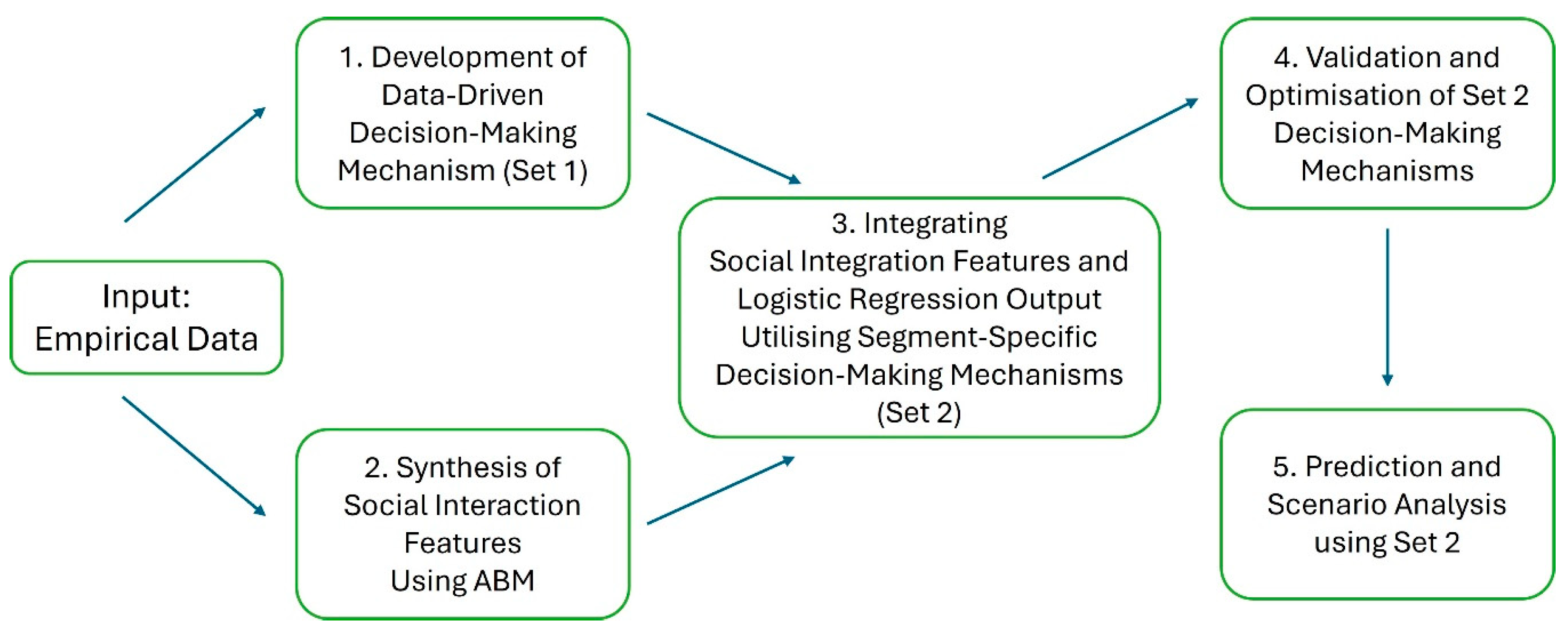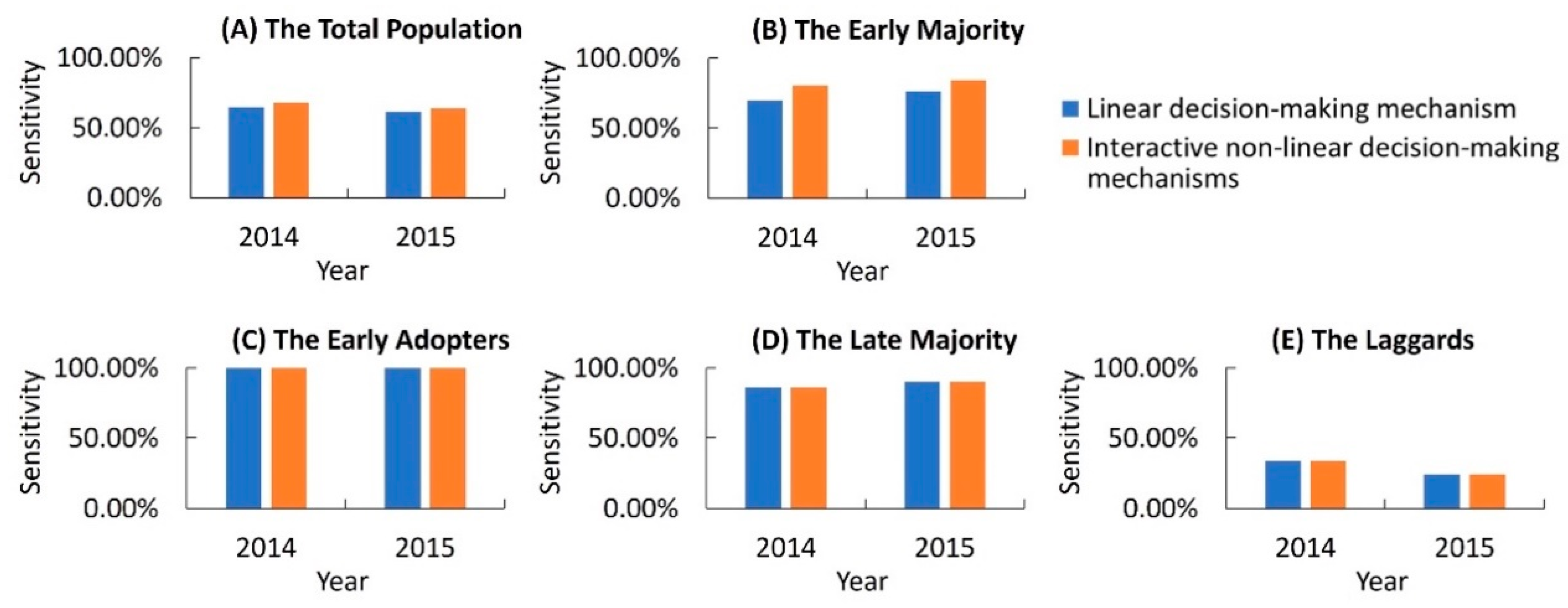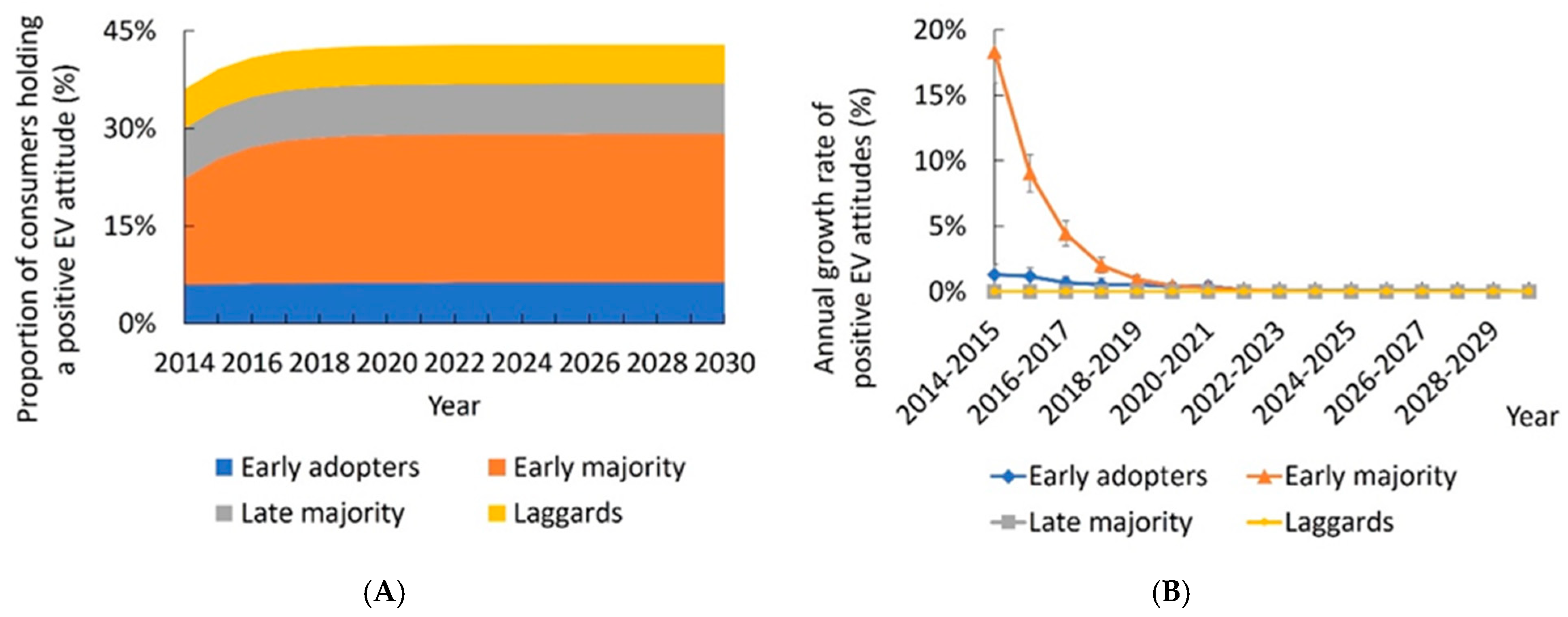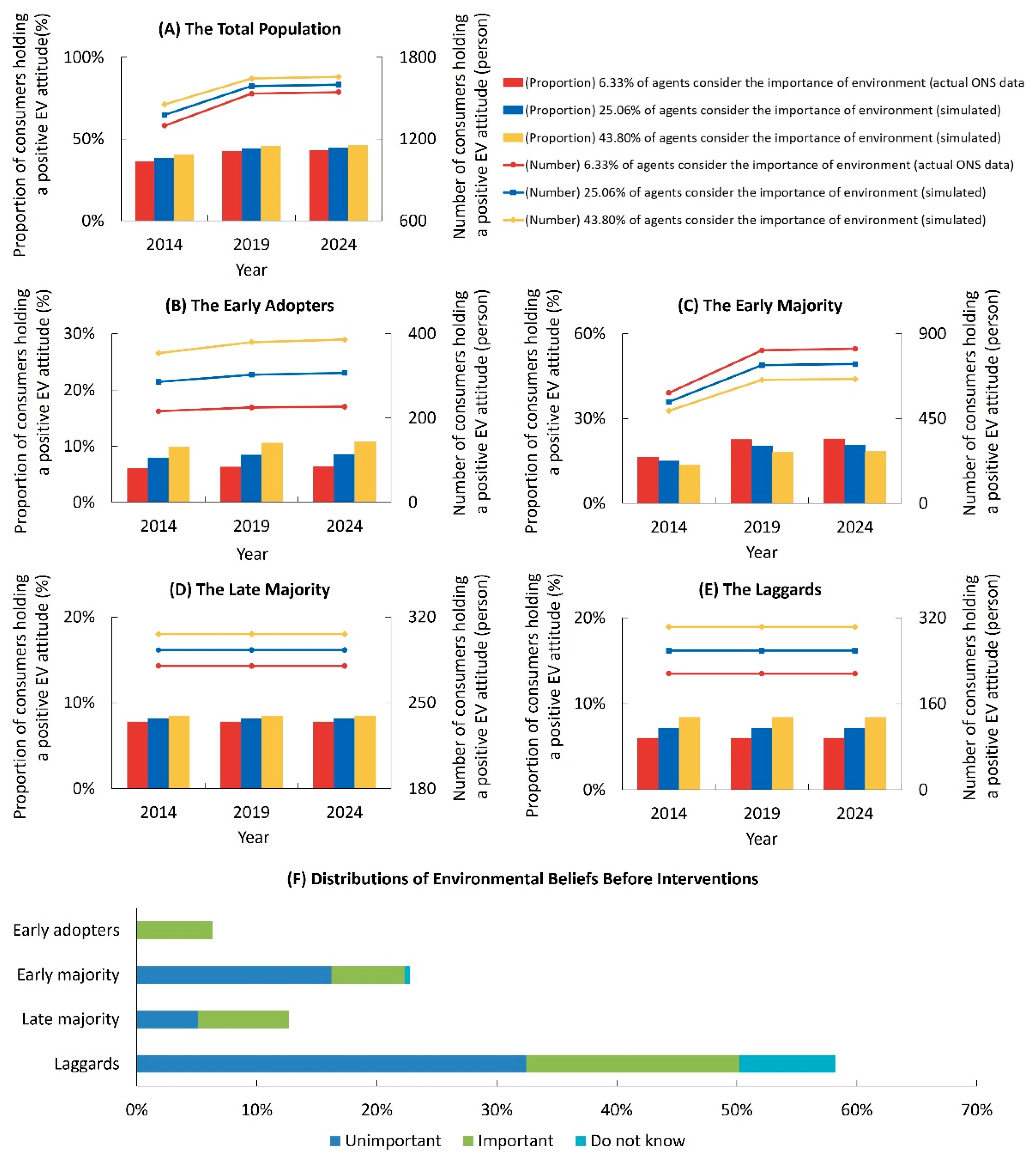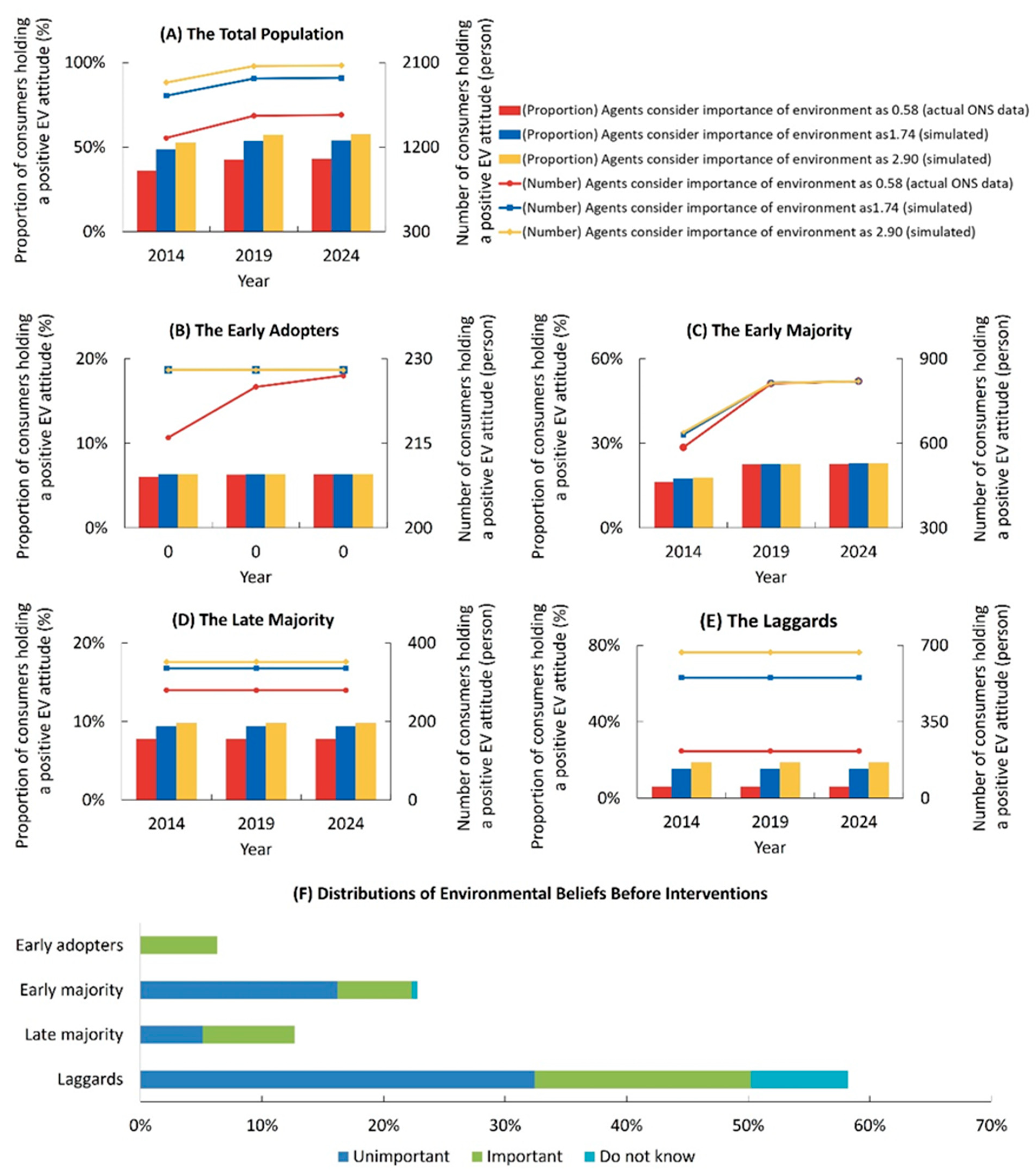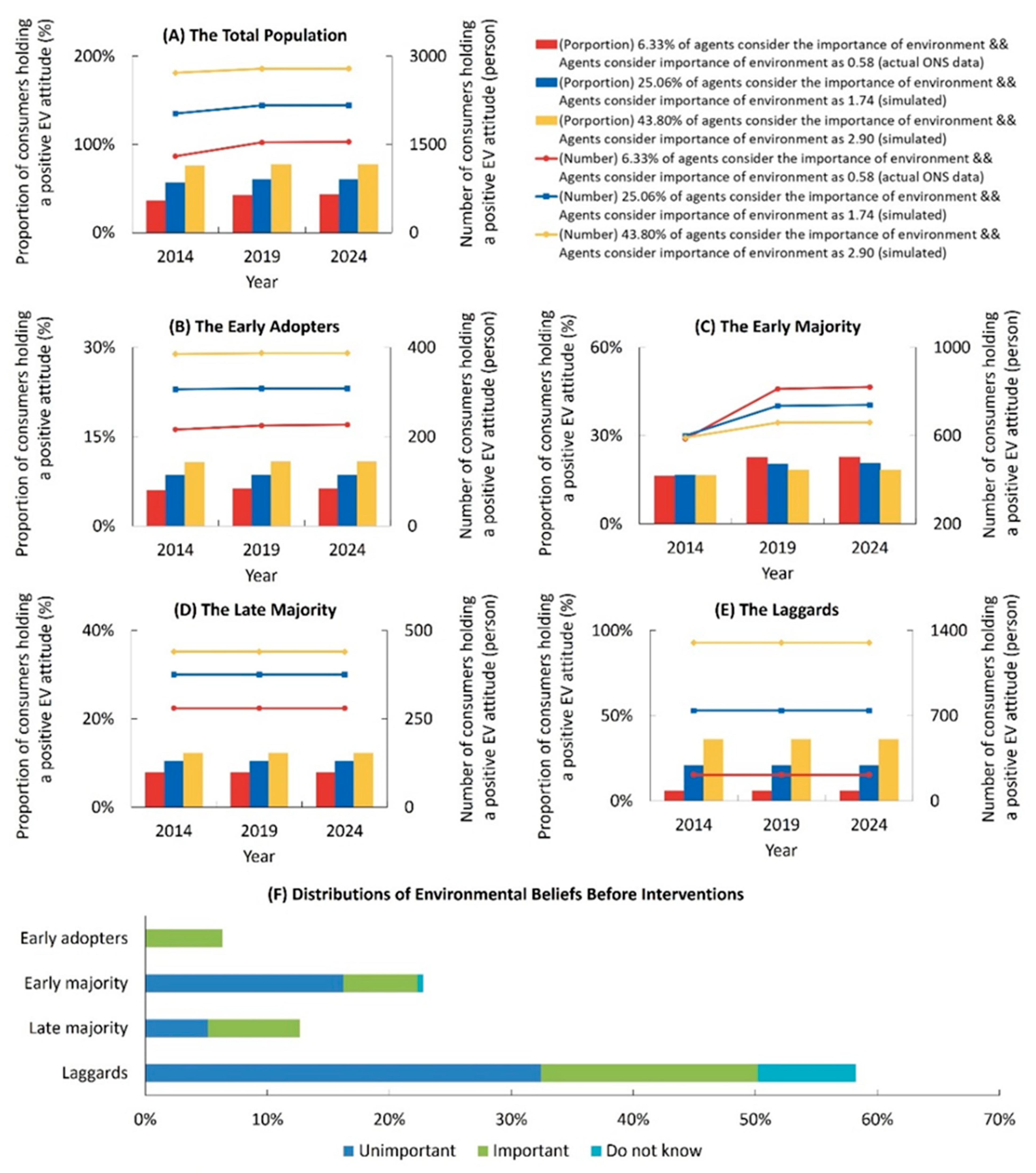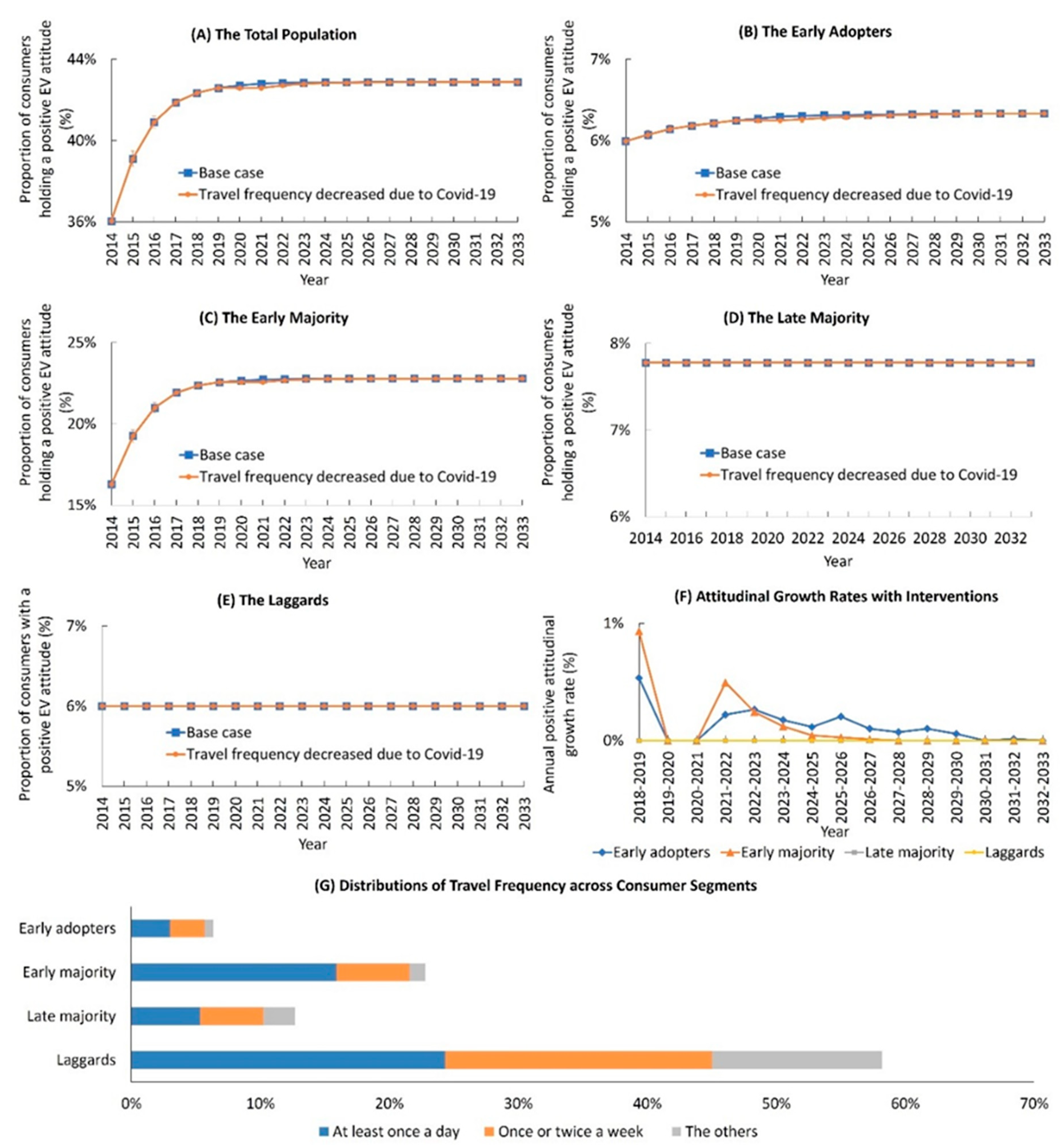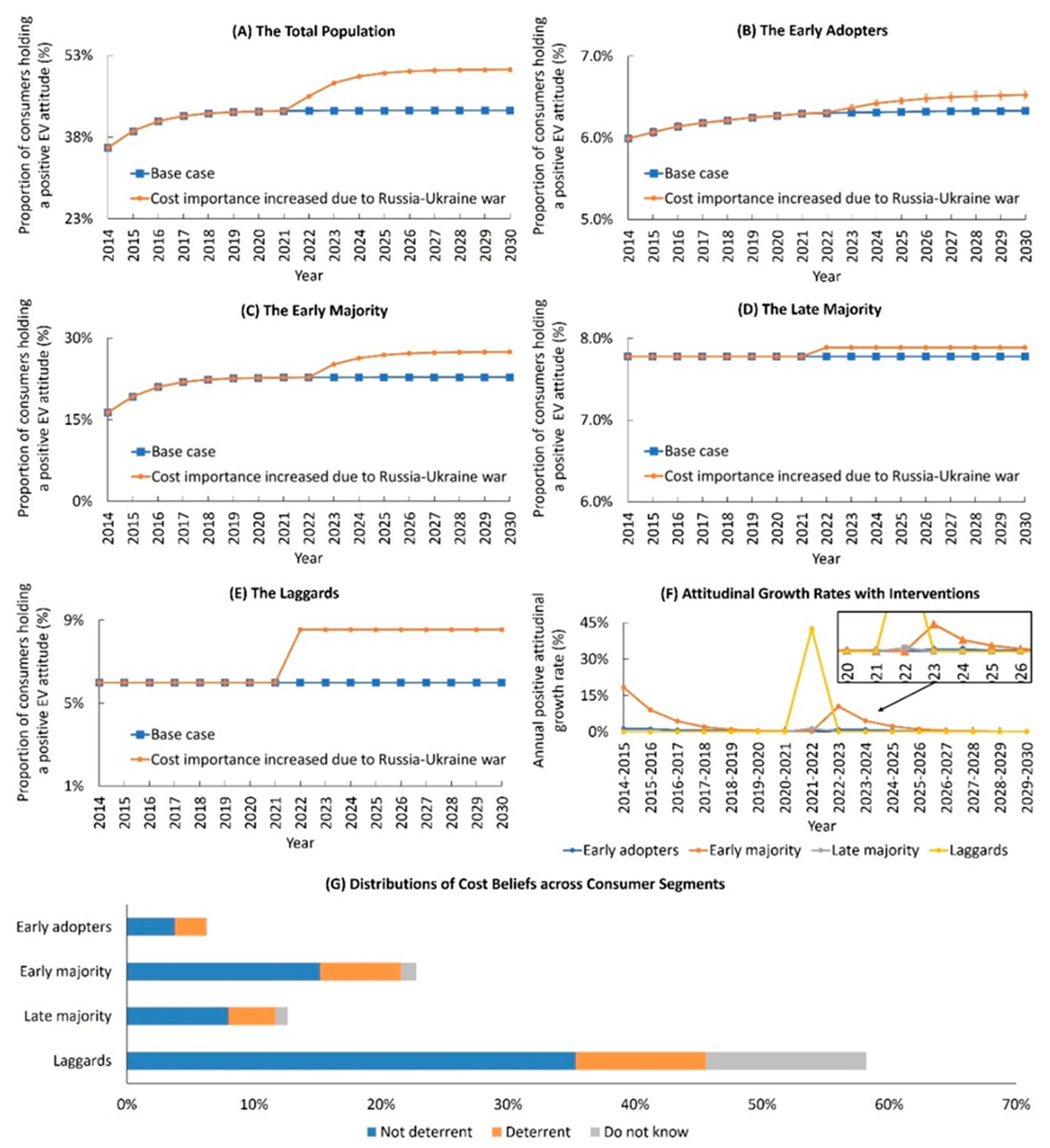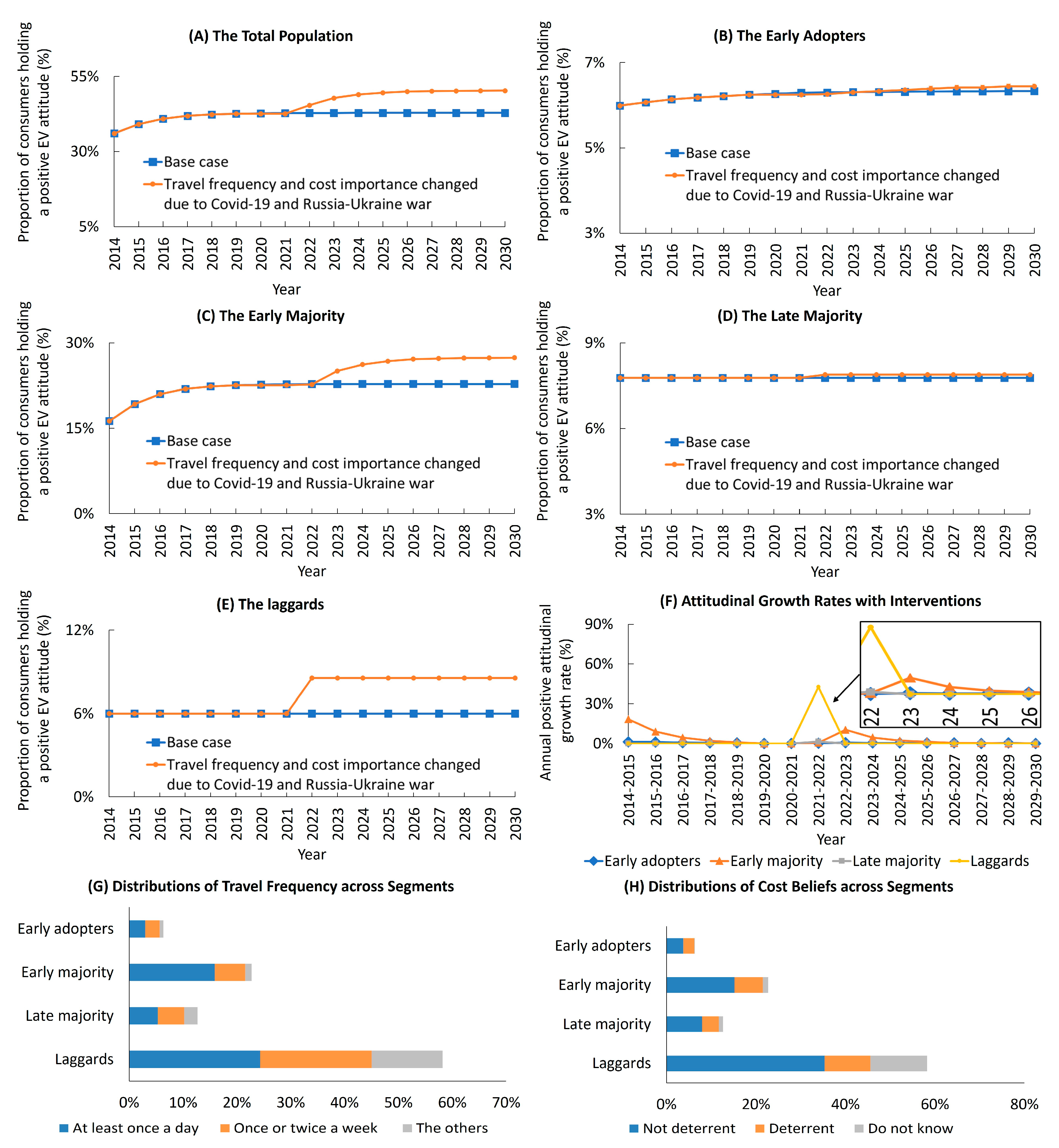1. Introduction
Understanding and predicting consumer decision-making in electric vehicle (EV) adoption is complex [
1,
2,
3]. These decisions are shaped not only by economic rationality but also by individuals’ socio-demographic characteristics, environmental beliefs, social norms, and exposure to innovations within their communities. Such influences vary across consumer segments and over time, making it difficult to model behaviours in a unified or generalised manner of modelling [
4,
5,
6]. Conventional top-down models often oversimplify these dynamics, limiting their ability to reflect real-world consumer diversity. As a result, researchers increasingly turn to behavioural theories and simulation-based approaches to better capture the heterogeneous and interactive nature of consumer decisions in the EV context [
7,
8].
To understand these diverse influences, researchers have commonly drawn on frameworks such as the Theory of Planned Behaviour (TPB) [
9], Social Influence Theory (SIT) [
10], and the Diffusion of Innovations Theory (DOI) [
11]. While each of these theories captures important behavioural drivers, previous studies often apply them in isolation or only partially, limiting their explanatory power in capturing complex, multi-level decision-making. For example, TPB-based models typically focus on individual intention without accounting for dynamic social influence, while SIT-driven approaches emphasise conformity and visibility but overlook underlying personal beliefs. DOI is frequently used to segment adopters, but rarely informs the decision-making rules within those segments. Moreover, many agent-based models rely on simplified utility or cost–benefit assumptions without a strong behavioural foundation, leading to under-specification of psychological and social mechanisms.
To address these limitations, we propose a mixed-method model under a multi-theory framework that integrates TPB, SIT, and DOI within an integrated simulation structure. In our model, TPB provides the basis for defining belief-driven attitudes. SIT informs the modelling of social interactions. DOI is used to segment the consumer population into adopter segments (e.g., early adopters, majority, laggards). These theories are operationalised within a hybrid architecture: supervised machine learning (SML) is used to extract interpretable decision rules from empirical data (UK national surveys), while agent-based modelling (ABM) simulates interactive, non-linear decision-making and context-sensitive behavioural dynamics. This integration enables us to represent segment-specific heterogeneity and to explore how beliefs, social influences, and contextual events shape pro-EV attitudes over time.
Our research identifies several key findings, which offer distinct contributions to the field. Specifically, this study contributes in three ways:
- (1)
We develop a novel, theory-driven agent-based model that integrates the theories of TPB, SIT, and DOI to simulate heterogeneous consumer attitude formation in the context of EV adoption.
- (2)
We introduce a hybrid methodology that integrates SML and ABM, allowing for the construction of segment-specific, non-linear decision-making mechanisms grounded in empirical UK data.
- (3)
We empirically demonstrate how different consumer segments respond to social interactions, environmental influences, and external events (e.g., pandemic and war conflict [
12], revealing important heterogeneity in pro-EV attitudes and offering actionable insights for policy and marketing strategies.
These contributions advance behavioural modelling methods and support more targeted, data-informed interventions to accelerate sustainable mobility transitions.
This paper is organised as follows.
Section 2 reviews relevant studies and identifies research gaps.
Section 3 details our methodology, including model design, development, validation and optimisation.
Section 4 presents the results and evaluates model performance, and
Section 5 concludes with key findings and suggestions for future research, including enhancements to the multi-theory framework for broader applications.
2. Research Gaps
The systematic literature review by [
13] summarised several common theories applied to model EV adoption behaviours using ABM. Guided by TPB [
9], these applications assumed that an individual’s intention to engage in EV adoption behaviour is shaped by attitudes, subjective norms, and perceived behavioural control. According to SIT [
10], these applications examined how social factors, such as conformity and norms, influence an individual’s beliefs and behaviours. Meanwhile, DOI [
11] categorised individuals based on their likelihood of adopting EVs, dividing them into consumer segments from innovators to laggards and explaining how EVs spread across a population over time.
However, these theories lack integration, limiting their ability to capture the multifaceted and heterogeneous nature of EV adoption behaviour. In this work, a multi-theory framework combining TPB, SIT, and DOI is applied to model consumer decision-making on attitude formation regarding private EV adoption. Within this framework, TPB highlights how consumer attitudes are shaped by a set of beliefs (e.g., environmental beliefs) that significantly influence attitude formation. This provides a theoretical foundation for constructing a decision-making mechanism on EV attitude formation driven by empirical survey data and SML techniques [
14]. SIT adds the influence of social norms on EV attitudes, supporting the synthesis of social interaction data for attitude investigation. DOI provides a structure for segmenting consumers by their readiness to adopt EVs, adding to the division of consumer segments. Other common innovation adoption theories, such as the Technology–Organization–Environment Framework [
15], are not incorporated in this framework as they focus on innovation diffusion within corporate settings rather than private adoption.
The importance of representing consumer heterogeneity is well-recognised in research on decision-making simulation [
16]. This heterogeneity includes differences in socio-demographics, beliefs, perceptions, attitudes, intentions, behaviours, decision-making mechanisms, and responses to contextual factors such as social interactions across consumer segments [
17]. ABM has emerged as a powerful tool to capture such heterogeneity, as it allows for modelling complex, individual characteristics and behaviours [
18,
19]. To contextualise the use of ABM in EV adoption research, we initially identified 441 peer-reviewed English-language articles from the Scopus database using two keyword combinations: (1) “agent based” and “electric vehicle” and (2) “multi agent” and “electric vehicle”. We then screened these articles based on title, abstract, and full-text content. Articles were excluded if they (a) did not apply agent-based modelling or related simulation methods, (b) focused solely on technical or infrastructural aspects of EVs (e.g., battery optimisation, grid integration), or (c) lacked any modelling of consumer behaviour. This process yielded 16 highly relevant studies published between 2011 and 2023 that explicitly applied ABM to simulate EV adoption from a consumer decision-making perspective. The 16 selected articles, as listed in
Table 1, were analysed in terms of (i) the theories and modelling methods used to construct consumer decisions, (ii) the extent of heterogeneity in these mechanisms across consumer segments, and (iii) the factors that influence these decision-making mechanisms.
Based on our review of the 16 selected studies, we identified four major dimensions through which consumer heterogeneity has been represented in ABM applications to EV adoption. These dimensions encompass socio-demographic characteristics, psychographic profiles, social and policy influences, and experiential or knowledge-based factors. Each of these has been modelled to varying degrees of depth and consistency across the literature, as summarised below.
Socio-demographic factors: The studies consistently find that demographic elements (such as age, gender, and occupation), geographic variations (e.g., urban vs. rural settings), economic status (e.g., income level), and cultural and ethnic diversity significantly influence consumer behaviours and preferences regarding EVs [
20,
24,
28,
32]. While these variables are easily quantifiable, they often act as proxies rather than explanations of psychological motivation.
Psychographic factors: Most of the studies have focused on the differences in consumers’ lifestyles, personality traits, values, perceptions of and attitudes towards products, brands, and innovations, as well as their risk tolerance and openness to adopting innovations. These psychographic factors are frequently used for market segmentation but are rarely operationalised into the modelling of decision-making mechanisms among consumer segments [
21,
25,
29,
33].
Social, media, and policy influence factors: Peer effects, information diffusion, and policy incentives (e.g., subsidies, access privileges) are widely acknowledged to shape EV preferences, yet the strength and interaction of these influences remain inconsistently modelled [
22,
26,
30,
34].
Product characteristics, knowledge, and experience: Studies also point to prior ownership experience, awareness of EV functionality, and performance comparisons as important factors influencing adoption, especially for later adopters [
23,
27,
31,
35].
Despite these thematic insights, prior modelling efforts have several limitations. Most assume homogeneous decision-making mechanisms, applying static or linear utility-based rules that oversimplify behavioural complexity. Only a small number of studies incorporate consumer heterogeneity explicitly or simulate how behaviour shifts across segments in response to social or environmental change. Moreover, theoretical integration remains fragmented. While frameworks like TPB, DOI, and game theory are occasionally applied, they are rarely combined systematically to explain multi-level behavioural dynamics. Few models are empirically validated at the individual level or account for feedback loops from real-world disruptions such as pandemics or geopolitical events. Our study addresses these gaps by constructing a multi-theory, empirically grounded agent-based model that integrates TPB, SIT, and DOI. It simulates segment-specific, non-linear decision mechanisms and external influences, validated using UK national survey data.
Regarding the generalisability of the four-factor framework, we note that while these categories are well supported in EV adoption literature, their applicability to other decision-making contexts—such as solar panels, shared mobility, or heat pumps—may vary. For example, the salience of social influence or environmental concern may differ based on cultural, technological, or policy conditions. Our work has included a brief discussion on this point to clarify the scope and limitations of our framework beyond EVs.
In summary, although existing studies acknowledge consumer heterogeneity in EV adoption, most assume uniform decision-making mechanisms and rely on simplified behavioural assumptions such as linear utility or cost–benefit models. These approaches often lack integration of behavioural theory and fail to represent how different consumer segments form attitudes in response to social and environmental influences. Theoretical application is fragmented, with limited use of established frameworks like TPB, SIT, or DOI, and minimal effort to integrate them systematically. Moreover, few studies validate behavioural mechanisms at the individual level or simulate the impacts of external events within social systems. This leaves a critical gap in modelling how heterogeneous, theory-informed, and context-sensitive attitudes toward EVs evolve over time across distinct adopter segments.
3. Construction of Agents’ Decision-Making Mechanisms Using Control Experiment
We conducted a control experiment to develop the decision-making mechanisms of consumer agents. The experiment involved comparing two distinct models: a control group with a linear decision-making process and an experimental group with interactive, non-linear decision-making. These models are described in
Table 2.
The control group model (Set 1) employs SML techniques and is driven entirely by a survey dataset on public attitudes towards EVs. In this model, the decision-making mechanism is linear and homogeneous across the entire consumer agent population, with differences determined solely by consumers’ socio-demographics and beliefs about EVs.
The experimental group model (Set 2) builds on the control group by incorporating social interactions simulated through ABM. This addition captures the influence of social factors on consumer attitude formation. The social interaction mechanisms are constructed using an interactive, non-linear function with heterogeneous parameters and decision-making logic tailored to different consumer segments (e.g., early adopters, early majority, laggards). The experimental model is subsequently validated and optimised for improved performance.
The segmentation of consumer agents follows the DOI framework, which categorises consumers into segments such as innovators, early adopters, early majority, late majority, and laggards. This classification is based on their propensity to adopt new technologies, like EVs, and is influenced by both psychological factors (e.g., beliefs about EV purchase costs) and demographic factors (e.g., age, gender). Our model examines two psychological factors: (i) beliefs about the importance of environmental protection and (ii) beliefs about electrically powered technologies. The former, referred to as environmental beliefs, capture consumers’ values and attitudes towards sustainability, environmental responsibility, and the perceived environmental benefits of EV adoption. These beliefs, along with two socio-demographic factors–income and education levels–are shown in prior research to significantly impact EV adoption [
36,
37]. For simplicity, these segments are assumed to be static in this model. This assumption is justified because the primary innovation of this work is to investigate the impact of consumer heterogeneity in EV attitude formation using ABM-SML integration. However, this assumption can be refined in future research.
The experiments in
Table 2 were clearly described as follows:
Set 1: Data-Driven Decision-Making Mechanism
Data: “Public Attitudes Towards Electric Vehicles” Opinions and Lifestyle Surveys collected by the Office for National Statistics [
38]
Technique: SML
Algorithms: Logistic regression and decision trees (C5.0, CART, and CHAID). Logistic regression and decision trees were chosen for their interpretability and ability to model different aspects of consumer decision-making in the context of EV adoption. Logistic regression offers a clear understanding of the relationship between independent variables (e.g., demographic factors, attitudes) and the likelihood of EV adoption, making it a robust baseline model. Decision trees, in contrast, provide a non-linear approach that captures complex variable interactions, useful for modelling heterogeneous consumer behaviours. Other algorithms, for example, Random Forest, Support Vector Machines, and Gradient Boosting, were initially considered as part of the research but were excluded because they lack interpretability and do not readily provide direct insights into the relationships between independent and dependent variables.
Objective: Categorise respondents’ attitudes towards EV purchasing based only on survey responses.
Implementation: The decision-making mechanism was created by training SML models using logistics regression and decision tree algorithms on the ONS dataset, respectively. The algorithm with the highest performance (logistic regression) is chosen and used to categorise the respondents’ attitudes based on the input features.
Set 2: Integrated Decision-Making Mechanisms
Data: A combination of the ONS datasets and synthesised social interaction attributes from the Amazon Mechanical Turk (AMT) data [
26,
39].
Technique: A hybrid approach integrating ABM and SML.
Algorithms: Logistic regression for the data-driven component and a customised algorithm for the artificially synthesised social interaction component.
Objective: Simulate attitude formation by accounting for individual characteristics and heterogeneous consumer segment reactions to social interactions.
Implementation: The consumer segments—early adopters, early majority, late majority, and laggards—were defined and operated based on attitudinal and demographic indicators from the UK national survey data, including innovation openness, environmental concern, education, and income levels. Each agent in the model was assigned to a segment using these characteristics, and segment-specific decision rules were then applied to simulate differences in belief sensitivity, social influence, and responsiveness to external events.
The SML model was trained on a dataset enriched with social interaction attributes. These attributes were synthesised using ABM, adhering to the principles of Social Influence Theory [
10]. Social influence was modelled as peer-to-peer interaction within an agent’s personal social network, along with exposure to visible EVs in the surrounding environment. The strength and conditions of social influence varied by consumer segment. For example, early adopters were influenced if at least one close friend held a positive EV attitude or if they observed EVs in their neighbourhood. The early majority required a majority of positively inclined friends or visual exposure to EVs, while the late majority required both a majority of positive peers and visible EV presence. Laggards were least sensitive, requiring at least twice as many positive as negative peer signals in addition to environmental visibility. This segment-specific rule set reflects different levels of social conformity and threshold sensitivity, enabling the model to simulate heterogeneous pathways of attitude change in response to social interactions.
Model validation and optimisation: Model parameters, which influence the likelihood of changes in EV attitudes resulting from social interactions among consumer segments, were validated through parameter variation experiments. A reasonable range of parameter values was tested to identify those that best align with empirical survey data on consumer attitudes toward EVs. The parameter values that achieved the highest model evaluation metric, G-mean, were selected, indicating the model’s optimal accuracy in classifying both positive and negative cases.
Control Experiment Setup
Objective: Evaluate whether integrating heterogeneous consumer segment reactions to social interaction into attitude formation mechanisms leads to more accurate and realistic classification of consumer attitudes towards EV purchasing. The construction of the mechanisms is guided by the multi-theoretical framework integrating the theories of TPB, SIT, and DOI. Specifically, TPB informs the development of the data-driven decision-making mechanism by identifying key attitudinal and belief variables derived from empirical survey data (Set 1). SIT is used to guide the synthesis and implementation of social interaction features through the agent-based model component. DOI underpins the segmentation of consumer agents and informs the design of segment-specific responses to social and environmental stimuli. Together, these theories ensure that each functional module is theoretically grounded and behaviourally relevant.
Methodology: Two sets of decision-making mechanisms were subjected to a series of tests to compare their performance in classifying attitudes and their ability to simulate attitude formation over time.
Metrics: The model’s ability to realistically simulate changes in attitudes over time was assessed using model validation at population (attitudinal trends) and individual (model sensitivity) levels.
Outcomes
Enhanced accuracy: We select Set 2, with its integrated approach, to classify attitudes more accurately towards EV purchasing, because it accounted for the heterogeneous influence of social interaction on consumer segments’ perceptions and decisions.
Realistic simulations: We expect Set 2, incorporating social interaction, to provide more realistic simulations of how attitudes towards EVs evolve over time, reflecting the complexities of real-world decision-making.
Insights into social influence: Our control experiment offers valuable insights into the extent to which social interaction (as artificially synthesised using agent-based modelling) influences consumers’ attitudes towards EV adoption decisions.
Reporting and Analysis
Section 4 presents the results of our control experiment, clarifying the benefits and limitations of integrating social interaction into decision-making mechanisms across consumer segments. These results provide insights into the practical implications of integrating consumer heterogeneity and social interaction into consumer behaviour models and suggest directions for future research and model improvement.
Summary of the SML-ABM approach for the integrated model
The model development progress, integrating SML and ABM, consists of five functional modules (
Figure 1):
Development of data-driven decision-making mechanism (Set 1): This module focused on creating the data-driven decision-making mechanism. A logistic regression classifier was developed using SML techniques to identify key socio-demographic and belief features associated with ONS consumers’ attitudes towards EV purchasing.
Synthesis of social interaction features using ABM: In this module, social interaction features were synthesised for segment-specific consumer agents using the ABM approach. These synthesised features enabled realistic social interaction dynamics within the agent population and consumer segments.
Integrating social integration features and logistic regression output utilising segment-specific decision-making mechanisms: The synthesised social interaction features were combined with the logistic regression output from Set 1 to create segment-specific decision-making mechanisms for attitude formation. The integration resulted in the construction of integrated decision-making mechanisms (Set 2) for consumer segments.
Validation and optimisation of Set 2 decision-making mechanisms: The module validated and optimised the decision-making rules of Set 2 through parameter variation and micro-validation experiments within the ABM. Optimised parameters for social interactions were selected for Set 2. Additionally, this module involved a performance comparison between Set 1 and the optimised Set 2 to evaluate improvements.
Prediction and scenario analysis: In the final module, the agent-based model, equipped with Set 2 and its optimised social interaction parameters, was used to predict consumer attitudes towards EV adoption and perform scenario analysis.
The integrated SML–ABM approach enabled a data-driven exploration of consumer attitudes by combining the strengths of both methodologies. SML was used to derive interpretable, data-driven rules for individual-level attitude classification based on real-world survey data, while ABM allowed us to simulate dynamic social interactions, feedback effects, and contextual influences that static models cannot capture. This hybrid framework supports realistic and segment-specific simulations of behavioural processes, offering both empirical grounding and computational flexibility. Compared to traditional econometric models or rule-based ABM alone, this integration enhances behavioural realism and strengthens model validation at both the individual and population levels.
4. Experimental Results
This section discusses the main findings and practical applications of the optimal model developed in our research.
Section 4.1 compares the model’s performance with a linear decision-making mechanism for the entire consumer agent population (Set 1) and the model with interactive, non-linear decision-making mechanisms tailored to consumer segments (Set 2). In
Section 4.2, we demonstrate the application of the optimised interactive, non-linear decision-making mechanisms within the integrated model to project the evolution of UK consumers’ attitudes towards EVs from 2014 to 2030.
Section 4.3 explores the influence of environmental beliefs on UK consumers’ attitudes towards EV purchasing, using the model as an investigative tool. Finally,
Section 4.4 highlights the model’s utility in conceptual and contextual estimation. This includes analysing the impact of reduced travel frequency due to pandemic diffusion and the rise in EV purchase costs resulting from the Russia–Ukraine conflict on consumers’ attitude formation.
4.1. Comparative Analysis of Decision-Making Mechanisms
Section 4.1 compares the model sensitivity of two different decision-making mechanisms, a linear mechanism and a set of interactive, non-linear mechanisms, using 2014 and 2015 ONS survey data. The linear mechanism employs a logistic regression function based on four socio-demographic factors and eight belief factors, including (i) environmental friendliness; (ii) importance of electrically powered technologies; (iii) preference for large engines; and five deterrents to EV adoption—(iv) lack of knowledge, (v) driving range, (iv) purchase costs, (vii) car tax, and (viii) insurance.
In contrast, the non-linear mechanism uses interactive functions that incorporate the same socio-demographic and belief variables, as well as additional social interaction factors. It also includes adaptations tailored to different consumer segments, enabling the model to better capture heterogeneity in attitude formation.
Figure 2 presents the sensitivity results for both mechanisms in capturing pro-EV attitudes across segments. The interactive, non-linear mechanism slightly outperforms the linear mechanism overall (
Figure 2A), primarily due to higher sensitivity in the early majority (
Figure 2B). This highlights the importance of social interactions and non-linear dynamics in accurately modelling attitudes in this key group.
Early adopters, however, show consistently high sensitivity to both mechanisms (
Figure 2C), indicating that their pro-EV attitudes may be driven more by personal characteristics or beliefs about EVs than by social interactions. Similarly, the late majority displays comparable sensitivity across both models (
Figure 2D), implying that while this group may be more risk-averse, the decision-making model has limited influence on their attitude formation. In contrast, laggards demonstrate low sensitivity with both mechanisms (
Figure 2E), highlighting their resistance to pro-EV attitudes and suggesting that neither model significantly enhances prediction accuracy for this group.
The findings emphasise the importance of incorporating non-linear processes and social interactions, particularly for segments like the early majority, where such influences are strong. However, the minimal impact on early adopters, the late majority, and especially laggards indicates a need for varied adoption strategies tailored to each group. For laggards, in particular, additional factors or alternative models may be needed to better understand and potentially influence their attitude formation.
4.2. Projection of UK Consumer Attitudes Towards EV Purchasing: 2014–2030
At this stage, we applied the optimised model, incorporating the set of interactive, non-linear decision-making mechanisms, to trace the evolution of positive attitudes towards EVs among UK consumers from 2014 to 2030, with a focus on the role of social interaction.
Figure 3A provides a detailed breakdown of positive attitudes towards EV purchasing across various consumer segments and the overall population during the sample period. The data indicate that positive attitudes toward EV purchasing grew significantly from 2014 to 2020, particularly among the early majority, whose share of positive attitudes surpassed that of other groups. This segment, likely influenced by social interactions, exhibited a rapid increase in positive sentiment early in this period. In contrast, early adopters maintained a stable level of positive attitudes throughout, suggesting that their sentiment was already well-established before broader social influences became prominent. Meanwhile, the late majority and laggards showed minimal changes, reflecting their stronger resistance to adopting pro-EV attitudes.
A closer examination of the data is presented in
Figure 3B, which focuses on consumer segments and their annual rates of transition to positive EV attitudes. The annual growth rate highlights the early majority’s responsiveness to social influence, with a sharp increase between 2014 and 2015, peaking at nearly 20%. After 2015, however, this rate declined significantly, levelling off by 2020 as the effects of social interaction diminished within this group. Early adopters, the late majority, and laggards exhibited consistently low growth rates, indicating limited responsiveness to social interactions.
These findings underscore the critical role of social interaction in shaping the early majority’s attitudes while highlighting its minimal impact on other segments. Early policy efforts could leverage social influence to accelerate EV adoption among the early majority. Post-2020, sustaining growth may require targeted interventions—such as financial incentives (e.g., subsidies and tax credits), expanding charging infrastructure, and implementing public educational campaigns to increase awareness of EV benefits—to engage more resistant groups, including the late majority and laggards. For example, Ahmad and Rahul found that concerns about charging infrastructure deter EV adoption in India, and that information interventions are particularly important for consumer segments with high sensitivity to infrastructure availability [
40]. They also highlighted the importance of awareness enhancement in promoting EV adoption.
These trends align with the theory of DOI, which posits that the early majority is most susceptible to social influence, while laggards are the least affected. The alignment of our findings with Rogers’ theory validates our model’s capability to discern the varied impacts of social interaction across consumer segments. By capturing this diversity, our model lays the foundation for developing nuanced, targeted innovation marketing strategies.
These strategies can enable businesses to refine their outreach, tailor their offerings, and optimise marketing efforts to address the needs of specific demographic cohorts. This approach enhances consumer engagement by ensuring that the right messages reach the right audiences at the right times.
4.3. Impact of Environmental Beliefs on EV Attitudes
In this section, we leveraged our optimised model across three scenarios to examine the impact of environmental beliefs on attitudes towards EV adoption. As previously defined, environmental beliefs refer to consumers’ perceptions of the importance of environmental protection and the role of EVs in supporting sustainability. Each scenario implemented a different intervention designed to influence consumer environmental beliefs:
Scenario 1 increased the percentage of consumers holding positive environmental beliefs within the overall population.
Scenario 2 strengthened the impact of positive environmental beliefs on EV attitude formation.
Scenario 3 combined the interventions of Scenarios 1 and 2.
Across all three scenarios, a positive relationship between environmental beliefs and pro-EV attitudes was identified.
4.3.1. Increasing Positive Environmental Beliefs in the Population
Scenario 1 examines the effects of environmentally friendly beliefs on consumer attitudes towards EV purchasing since 2014. It highlights the complex interplay between environmental beliefs, social interaction, and consumer attitudes, providing key insights for designing effective pro-EV interventions.
In this setting, a percentage of consumers were prompted to transition from considering environmental friendliness as unimportant (or being uncertain) to regarding it as important (i.e., holding positive environmental beliefs) in 2014. The tested percentage ranged from 0% (base case) to 40%, in increments of 20%.
Figure 4 illustrates the impact of pro-environmental beliefs on consumer attitudes toward EV purchasing from 2014 to 2024. Across the total population (
Figure 4A), a positive correlation is observed; as more consumers adopt pro-environmental beliefs, positive attitudes toward EVs also increase. This trend is especially strong for early adopters and the early majority (
Figure 4B,C), who show a significant shift in positive EV attitudes from 2014 to 2019, driven by social interaction. However, a saturation effect occurs post-2019, indicating that attitudes within these groups have stabilised, and further influence from social or environmental beliefs has a reduced effect.
In contrast, the late majority and laggards (
Figure 4D,E) exhibit consistent yet limited improvement in positive EV attitudes over the period, relying more on persistent pro-environmental beliefs than on social interactions. The findings are consistent with the empirical survey data distribution in
Figure 4F, which shows that early adopters and the early majority are more likely to prioritise environmental beliefs, making them more responsive to early shifts. Conversely, a substantial portion of the late majority and laggards remain indifferent or unsure about environmental concerns, highlighting a barrier to influencing these groups. This suggests that more persistent engagement strategies—such as tailored messaging, long-term awareness campaigns, or bundling environmental appeals with economic incentives—may be necessary to shift attitudes in these segments.
These findings suggest that the synergy between pro-environmental beliefs and social interaction is most impactful for early adopters and the early majority, particularly in the early adoption phase. As social influence diminishes, strategies for these segments should focus on reinforcing positive attitudes rather than conversion. For the late majority and laggards, long-term approaches such as economic incentives, targeted messaging, and infrastructure improvements may be essential to drive EV adoption.
4.3.2. Strengthening the Importance of Environmental Beliefs in Decision-Making
Scenario 2 examines the effects of amplifying the perceived importance of consumers’ pro-environmental beliefs on their attitudes toward EV adoption. The baseline importance of pro-environmental beliefs was established using a logistic regression coefficient of 0.58. To simulate stronger belief influence, we scaled this coefficient to 1.74 and 2.9—representing moderate and high-intensity interventions, respectively. Practically, these values reflect hypothetical policy scenarios where public awareness campaigns or social messaging significantly increase the salience of environmental concerns in shaping attitudes. For decision-makers, the increasing coefficients model how intensifying the perceived importance of environmental protection (e.g., through media, education, or community initiatives) could amplify the likelihood of positive EV attitudes within different consumer segments.
Figure 5 illustrates the influence of environmental beliefs on EV adoption across consumer segments. Across the total population (
Figure 5A), there is a clear positive correlation between the importance of environmental beliefs and positive attitudes toward EVs. However, as interventions intensify, a saturation effect emerges, with diminishing returns at higher levels of belief reinforcement. Early adopters and the early majority (
Figure 5B,C) show the most significant shifts between 2014 and 2019, primarily due to social interactions. After 2019, their attitudes stabilise, indicating that social influence has reached its peak, and additional belief-based interventions have minimal impact.
In contrast, the late majority and laggards (
Figure 5D,E) exhibit a steady yet modest increase in positive attitudes, largely unaffected by social interactions. These groups rely more on persistent, reinforced pro-environmental beliefs rather than social pressures.
Figure 5F shows that early adopters and the early majority are more receptive to environmental interventions due to a higher initial concern for environmental issues, while the late majority and laggards are more indifferent or uncertain, underscoring the challenge of reaching these groups.
The findings suggest that social interaction is most effective for early adopters and the early majority during the initial adoption phase (2014–2019). Beyond this period, maintaining growth may require novel strategies, like economic incentives or technological innovations. For the late majority and laggards, sustained campaigns focused on environmental beliefs, combined with financial and informational outreach, may be necessary to foster positive EV attitudes across all segments.
Overall, the results reveal the complex interplay between the perceived importance of environmental beliefs, social interaction, and consumer attitudes toward EVs. They underscore the necessity of a detailed, segment-specific approach to fostering positive consumer attitudes, taking into account the varying influences of social and cognitive factors across consumer groups.
4.3.3. Combined Influence of Importance and Prevalence of Environmental Beliefs
Scenario 3 investigates the combined impact of increasing both the perceived importance and the prevalence of positive environmental beliefs among consumers within a context shaped by social interaction.
Figure 5 presents the experimental results.
Figure 6A reveals a positive relationship between environmental belief interventions and pro-EV attitudes across the population. As both the importance and prevalence of environmental beliefs increase, the proportion of pro-EV attitudes rises. This effect is most significant when interventions simultaneously increase both dimensions of environmental beliefs. Early adopters (
Figure 6B) display a strong, positive correlation, with social interactions amplifying their pro-EV attitudes between 2014 and 2019. In contrast, the early majority (
Figure 6C) unexpectedly shows a decline in pro-EV attitudes as environmental beliefs intensify. This anomaly may reflect psychological reactance, where individuals resist perceived persuasive pressure, or a saturation effect from overexposure to environmental messaging. Such findings suggest that, for this segment, overly repetitive or intense messaging might trigger disengagement or scepticism, highlighting the need for more balanced, context-sensitive communication strategies. This unexpected pattern warrants further exploration in future studies, particularly using experimental or qualitative approaches to unpack resistance mechanisms among otherwise receptive groups.
The late majority and laggards (
Figure 6D,E) respond positively to reinforced environmental beliefs over time, showing stable growth in pro-EV attitudes unaffected by social interactions. For these segments, belief-based interventions drive attitude change, indicating that gradual, persistent messaging could be effective.
Figure 6F highlights that early adopters and the early majority start with higher levels of environmental concern, making them more susceptible to initial shifts, while the late majority and laggards exhibit lower baseline interest, underscoring the need for continuous reinforcement.
These findings suggest a tailored approach; for early adopters, social interaction and belief reinforcement are highly impactful in the early stages (2014–2019). For the early majority, it is essential to investigate the unexpected resistance to refine intervention strategies. For the late majority and laggards, long-term, belief-focused strategies are recommended, as sustained messaging and consistent emphasis on environmental benefits appear effective in gradually shifting attitudes.
Scenario 3 highlights the complex interplay of environmental beliefs, perceived importance, and social interaction in shaping consumer attitudes towards EV adoption. The findings emphasise the need for a multi-faceted approach to cultivating positive attitudes, one that acknowledges the varying impact of cognitive and social factors across distinct consumer segments.
The three scenarios provide a practical demonstration of the TPB, illustrating how pro-environmental beliefs shape positive attitudes towards EV purchasing across the general population and specific consumer demographics. Additionally, integrating DOI enables a nuanced examination of the evolving impact of environmental beliefs on EV attitudes across various adoption phases.
Our findings empirically demonstrate the interactive dynamics between social factors and consumers’ environmental beliefs, aligning seamlessly with the tenets of SIT. This underscores the mutually reinforcing roles of societal interaction and individual belief systems in shaping attitudes towards EV adoption.
The observed heterogeneity in how environmental beliefs impact EV attitudes across different consumer segments offers valuable insights for marketers and policymakers. For marketers aiming to optimise resource allocation and campaign efficacy, a tailored strategy is crucial. To appeal to the early majority, the key lies in amplifying the perceived importance of positive environmental beliefs, rather than merely expanding the base of consumers who hold such beliefs. For other segments, a dual-strategy approach–boosting both the importance and prevalence of positive environmental beliefs–may yield a greater positive impact on EV attitudes.
For policymakers, these insights can inform the strategic deployment of incentives and initiatives. Targeting environmental beliefs in the early stages of EV adoption can establish a solid foundation for fostering positive consumer attitudes. For the late majority and laggards, encouraging social interaction is crucial. Organising pilot events and community-focused activities centred around EVs could serve as a catalyst, nudging these groups towards adoption.
Our findings emphasise the importance of a segmented approach to studying the decision-making mechanisms of different consumer segments. Recognising the unique needs and characteristics of these demographics allows for a comprehensive analysis that is essential for crafting effective marketing strategies and policy frameworks. Such an approach brings us closer to a future when EV adoption is deeply embedded in society.
4.4. Impact of Changes to Travel Patterns and Price Variations on UK Consumers’ Attitudes Towards EVs
Using the optimised integrated model, we investigated the interaction of various contextual factors and their influence on consumer attitudes towards EV purchasing through three scenarios: reduction in travel frequency (
Section 4.4.1), increase in EV costs (
Section 4.4.2), and a comprehensive analysis considering both elements simultaneously (
Section 4.4.3).
4.4.1. Analysis of Changes to Travel Patterns
The TBP offers a valuable framework for examining the interplay between travel frequency and the adoption of EVs, particularly in relation to perceived behavioural control and subjective norms. A higher travel frequency amplifies the demand for reliable transportation options and exposes individuals to prevalent social interactions (e.g., observations of EVs on the roads), potentially fostering positive attitudes towards EV adoption [
20].
From the perspective of DOI, travel patterns significantly influence the rate of EV adoption across different consumer segments. Frequent travellers, such as regular commuters and long-distance travellers, are more likely to recognise the benefits of EVs, including cost efficiency and environmental impact, positioning them as potential early adopters. Their experiences with EVs could, in turn, encourage broader adoption, aligning with Rogers’ theory.
SIT further elucidates how frequent travellers impact the EV adoption landscape. Their habits can trigger identification and internalisation processes within their social networks, thereby increasing the rate of EV uptake. However, it is important to note that empirical studies have reached inconsistent conclusions regarding the effect of travel frequency on EV adoption.
The pandemic-induced reduction in travel during 2020 and 2021 created an unprecedented shock to travel patterns.
Figure 7 illustrates the impact of pandemic diffusion on EV attitudes across consumer segments. In
Figure 7A,C, reduced travel during pandemic diffusion (2020–2021) led to decreased visibility of EVs, resulting in a temporary dip in pro-EV attitudes. Post-2022, as travel resumed, these attitudes began to recover, with the early majority rebounding faster than early adopters, likely due to increased exposure to EVs as commuting patterns normalised.
In contrast,
Figure 7D,E show stable attitudes throughout pandemic diffusion, as less frequent travel limited EV exposure in these groups, making them less responsive to changes in travel patterns. This stability suggests that these segments are more resistant to external disruptions and may require targeted interventions, such as policies or incentives, to influence their attitudes.
Figure 7F further highlights segment-specific differences: the early majority experienced a rapid recovery in positive sentiment due to the return of social interactions, even surpassing early adopters, who showed a more gradual recovery. Meanwhile, the late majority and laggards maintained consistent growth, underscoring their reliance on long-term factors rather than short-term shocks.
Figure 7G provides the distribution of travel patterns across consumer segments before the distribution, offering a comprehensive view of the experimental settings.
These findings underscore the importance of visibility and exposure for travel-oriented segments. To support post-pandemic recovery in pro-EV attitudes, strategies could include targeted marketing and expanded charging infrastructure in high-traffic areas. For the late majority and laggards, long-term approaches focusing on education, incentives, and infrastructure are essential. By understanding how external shocks like pandemic diffusion influence each consumer segment, policymakers and stakeholders can design resilient, adaptive strategies that foster sustained EV adoption across diverse demographics.
4.4.2. Analysis of Purchase Price Variation
The TPB provides a valuable framework for analysing the impact of EV purchase costs on consumers’ EV adoption. Purchase costs influence several key factors, including consumers’ attitudes, subjective norms, and perceived behavioural control. High upfront costs associated with EVs can foster negative attitudes and perceptions of unaffordability, deterring potential buyers [
26].
According to the DOI, purchase costs play a critical role in determining adoption rates. High prices might discourage early adopters, while declining costs over time could encourage adoption among the early majority, the late majority, and laggards. SIT further elaborates on how social norms and peer interactions shape perceptions of cost and influence the intention to adopt EVs. Despite these theoretical insights, empirical studies investigating the impact of purchase cost beliefs on EV adoption have produced inconsistent findings, highlighting the complexity of this issue.
The outbreak of the Russia-Ukraine conflict in 2022 had a significant impact on EV purchase costs.
Figure 8 illustrates how this geopolitical event affects EV attitudes across consumer segments. Early adopters (
Figure 8B) display minimal change in attitudes, likely because this group prioritises environmental and innovation-related motivations over cost considerations. For the early majority (
Figure 8C), a significant attitude boost occurs in 2023, driven primarily by increased social interactions rather than cost changes. This underscores the strong influence of peer acceptance within this segment.
The late majority (
Figure 8D) shows marginal growth in positive attitudes, reflecting moderate cost sensitivity to cost fluctuations. In contrast, laggards (
Figure 8E) undergo the most dramatic shift, with a sharp rise in pro-EV sentiment from 0% in 2021 to 43% in 2022. This suggests that high costs acted as a key driver for this group, possibly by increasing the perceived value of EVs as fuel costs rose during the conflict.
The annual growth rates (
Figure 8F) further reinforce these findings. Laggards show substantial attitude gains driven by cost factors, while early adopters and the late majority remain relatively unchanged. The early majority’s notable increase in 2023 highlights the critical role of social interactions in shaping their attitudes.
Figure 8G provides the distributions of cost beliefs across consumer segments before the intervention, offering a comprehensive view of the experimental settings.
These findings suggest the need for tailored interventions. For laggards, financial incentives, such as subsidies or tax breaks, may be most effective in addressing cost-related barriers. For the late majority, social network engagement and visibility campaigns could leverage peer influence to drive adoption. Overall, a multi-faceted approach–combining financial, social, and policy measures–is essential to maximise EV adoption across all consumer segments.
These findings align with the DOI, highlighting the differing responses of consumer segments to cost pressures and social influences. It is evident that EV costs, travel frequency, and social interactions collectively shape consumer attitudes, underscoring the complex and interrelated nature of these factors in influencing EV adoption.
4.4.3. Analysis of Travel Patterns and Purchase Price Variation
Figure 9 illustrates the combined effects of pandemic diffusion, the Russia–Ukraine conflict, and social interactions on EV attitudes across consumer segments. During the pandemic diffusion in 2020 and 2021, reduced mobility led to a decline in positive EV attitudes among the general population, early adopters, and the early majority (
Figure 9A–C). The decreased visibility of EVs dampened sentiment, emphasising the importance of exposure in shaping consumer attitudes. Post-2022, attitudes recovered, driven by heightened social interactions and a surge in EV costs resulting from the Russia–Ukraine conflict. The rising costs reinforced the perceived long-term economic benefits of EVs, bolstering positive sentiment.
For the late majority and laggards (
Figure 9D,E), cost increases had a more pronounced impact, as they exhibited minimal sensitivity to social factors. The laggards experienced a dramatic 43% growth in positive sentiment in 2022, underscoring their strong cost sensitivity to cost pressure. In contrast, the late majority showed only a modest increase of about 1%, indicating a more limited response to cost changes.
Figure 9F highlights the early majority’s notable 10.4% rise in positive attitudes in 2022, attributed to resumed social interactions and cost considerations. Early adopters, however, showed a smaller increase of 0.71% in 2023. Segment-specific travel pattern distributions (
Figure 9G) and cost belief distributions (
Figure 9H) provide a comprehensive view of this experimental setting.
These findings underscore the need for targeted interventions: restoring social interactions and reinforcing visibility through campaigns in high-traffic areas may sustain growth in the early majority. Cost-focused incentives, such as subsidies or financial assistance programs, could effectively address the cost sensitivity of laggards and drive their adoption. Tailoring strategies to the unique needs of each segment can maximise EV adoption, balancing financial, social, and policy measures across the broader consumer landscape.
When all scenarios are considered simultaneously, a complex interplay emerges. The negative consequences of reduced travel due to pandemic diffusion were counterbalanced by the positive influence of increased EV costs, illustrating the intricate dynamics shaping consumer attitudes. This delicate balance underscores the need for policymakers to carefully analyse these interconnected factors to optimise resource allocation. By addressing these challenges strategically, policymakers can promote a sustainable transition to EVs, ensuring that interventions effectively support consumer adoption while fostering long-term societal and environmental benefits.
5. Conclusions
This study developed an integrated, theory-informed modelling framework to explore consumer heterogeneity in EV attitude formation. By combining ABM and SML under the TPB, SIT, and DOI, we simulated how social interactions, environmental beliefs, and external events influence pro-EV attitudes across four consumer segments.
The findings reveal that early adopters and the early majority are responsive to pro-environmental beliefs, social influences, and external events, including the pandemic and the war conflict. In contrast, the late majority and laggards show more stable and resistant responses. Notably, the early majority displayed a saturation or even a reversal effect when exposed to strong combined interventions, potentially due to message fatigue or psychological reactance—an area warranting further research.
This study makes three key contributions to the field of adoption research, including (1) theoretical contributions, (2) methodological innovations, and (3) practical implications. First, it presents a multi-theory behavioural modelling approach that integrates multiple behavioural theories and is grounded in empirical UK survey data. This theoretical integration allows for a more detailed understanding of consumer heterogeneity and the psychosocial mechanisms that shape attitudes toward EV adoption. It advances the field by moving beyond single-theory or descriptive approaches and providing a structured lens through which to examine behavioural diversity across consumer segments.
Second, the research develops a hybrid modelling framework that combines SML with ABM to generate segment-specific, non-linear decision-making mechanisms. This approach enables the simulation of individual-level attitude formation while capturing complex interactions such as social influence and belief salience. The use of micro-validation and parameter optimisation further strengthens the empirical grounding of the model, offering a replicable methodology for studying other forms of sustainable technology adoption.
Third, our findings underscore the importance of tailored, segment-specific strategies to promote EV adoption. Given the diverse drivers of consumer attitudes—from environmental concern to social influence—policy and marketing interventions should be designed with behavioural segmentation. Strategic approaches that align with the motivations of different consumer groups are likely to be more effective in accelerating EV adoption.
Several limitations should be noted. First, while the dataset used—drawn from UK national surveys—is valid and broadly representative, it may still be subject to biases such as self-reporting errors, non-response bias, and sampling limitations. Additionally, the model uses static segmentation and UK-specific data, which may limit generalisability to other cultural or regulatory contexts. Second, the current framework focuses on attitude formation rather than the full behavioural adoption process. Third, although we simulate external events and environmental concerns, real-world behavioural responses to crises may involve emotional or socio-political dynamics not captured in this version.
The model incorporates interventions—such as changes in environmental beliefs, travel behaviours, and perceived costs—by applying them randomly across the agent population. While this allows for general evaluation of their effects on pro-EV attitudes, it does not yet control for targeted exposure across specific consumer segments. Additionally, beliefs such as lack of knowledge and purchase cost are treated as psychological deterrents within the belief-based structure, but their differentiated influence across segments is inferred from the simulation results rather than explicitly controlled. Future work could refine this by systematically applying targeted interventions to evaluate segment-specific responsiveness.
The model’s forecasts from 2014 to 2030 are also based on several simplifying assumptions: consumer segments remain static; social network structures do not evolve; environmental beliefs change only through predefined interventions; and no major policy interventions occur beyond those simulated. These assumptions, while necessary for tractability, may influence the precision of long-term projections. Additionally, although ABM enables simulation of heterogeneous and interactive behaviours, it requires detailed individual-level data to parameterise rules and validate outcomes—data that may not be available in other regions or contexts. Simulating large agent populations with feedback-rich dynamics also introduces computational complexity, which may limit scalability. Finally, as the model is not designed as a binary classifier, we did not use metrics such as ROC or AUC. Instead, model performance was assessed through sensitivity at the individual level and alignment with observed population-level adoption trends.
Future research could expand the model to simulate intention and behaviour stages, incorporate dynamic segment transitions, and integrate richer behavioural data across diverse geographies. For cross-cultural adaptation, researchers are encouraged to calibrate the model using local survey data, behavioural norms, and culturally specific factors influencing technology adoption. Collaborating with regional experts can also improve contextual relevance and ensure cultural validity. We also suggest that future studies implement controlled experiments within the ABM framework to vary interventions—such as belief cues, pricing strategies, or knowledge campaigns—by consumer segment. This would allow more rigorous testing of segment-level sensitivity to specific behavioural levers and inform precision targeting for marketing or policy design. Additionally, exploring message framing, exposure timing, and evolving social network structures could yield deeper insight into the mechanisms of EV attitude formation under dynamic external conditions. Finally, applying this framework to other sustainability transitions (e.g., heat pumps, shared mobility, or solar adoption) could test its generalisability and extend its policy relevance.
